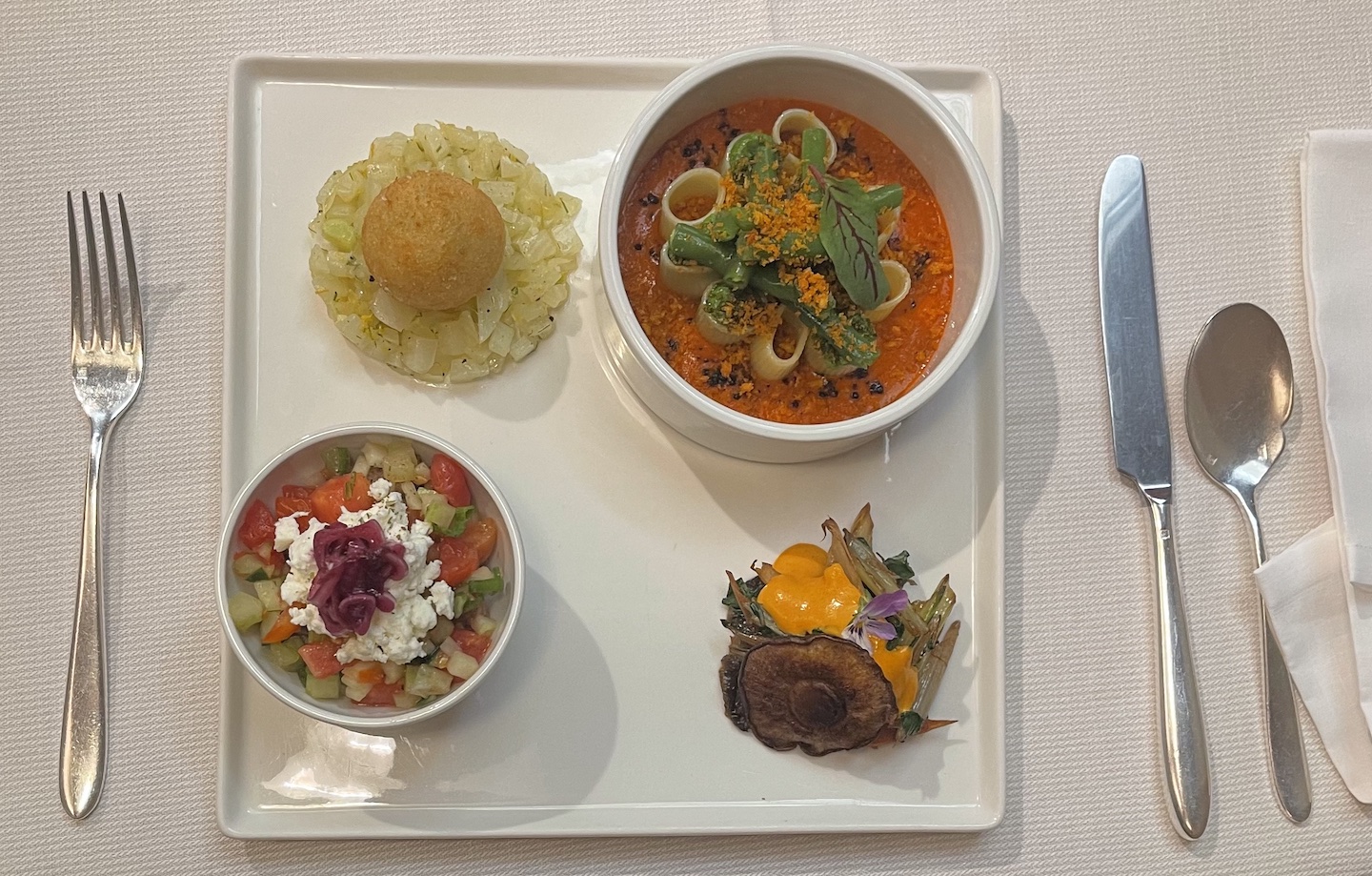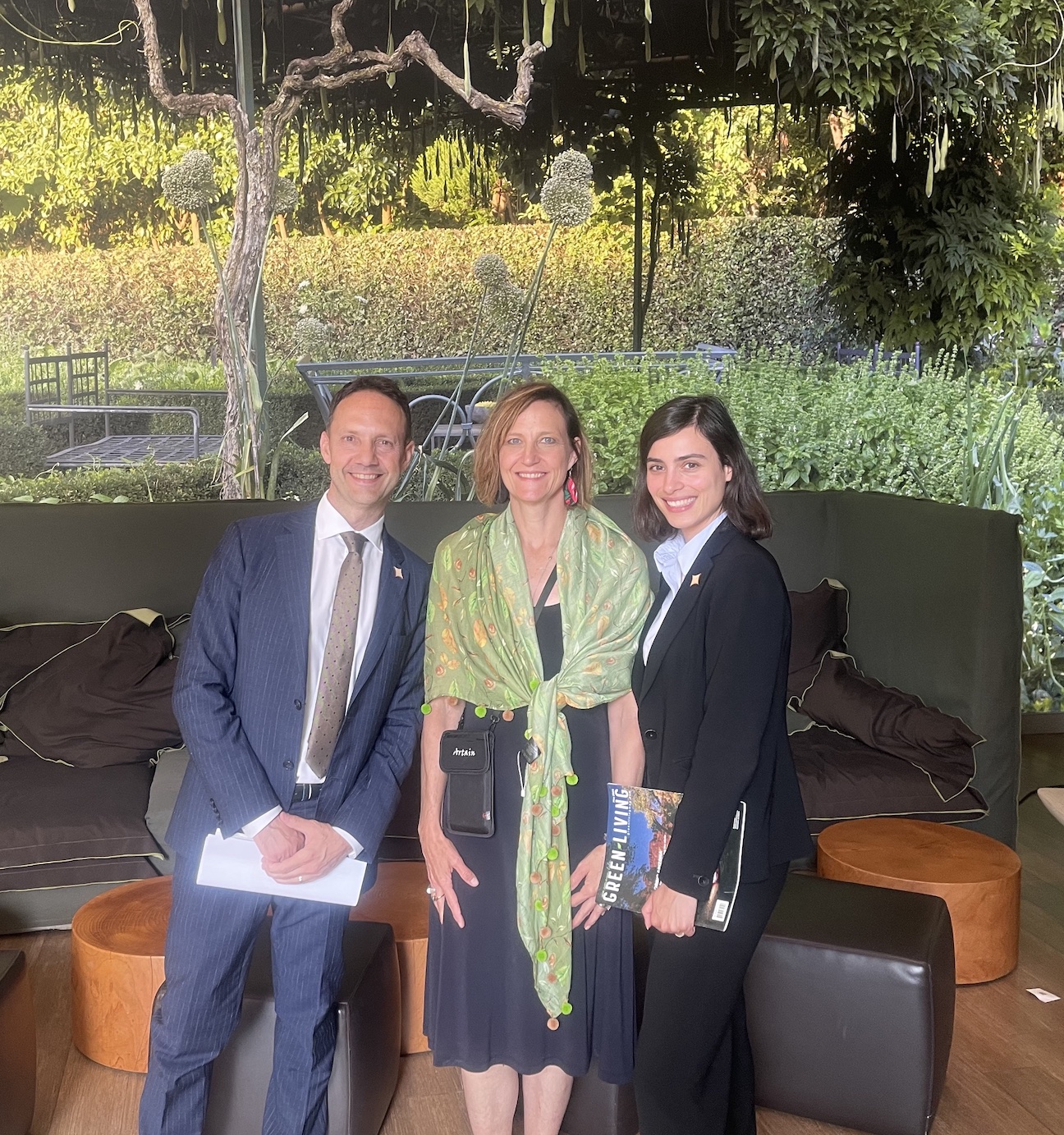By Dorie Morales
We were so excited to be invited to our dear friends’ Claudia Kretchmer and Michael Lee wedding. As a bonus, we planned an eco-conscious itinerary, traveling to Claudia’s hometown of Milan, as well as to Chiavenna and Lake Como. I emailed Ecobnb and the kind and helpful founder, Silvia, suggested a great agritourism location in the Lake Como area.
When we arrived in Milan, we rented a small car, and we stayed at the eco Hotel Milano, a certified and verified EcoWorldHotel by DNV, an international independent third-party certification body.
We ate a delicious pizza and salad at a local restaurant, Ristorante Planet. In the morning, I found an eco-friendly Italian magazine in the hotel’s restaurant while having a cappuccino made with non-dairy milk. One of my favorite things about the hotel was that the table in the room was made of corrugated cardboard. It was in the heart of Milan, and the owners work to daily to reduce their environmental impact.
Then we were off to Chiavenna, Province of Sondorio, which is a small romantic Alpine mountain town that everyone should visit at least once in their lifetime. The town is nestled in the Italian Alps, so the views of the mountains are breathtaking from every direction, and the river Mera runs through the town. We spent the afternoon with Claudia as our tour guide, visiting with all the family and friends who had traveled for the wedding and learning about Chiavenna and its history, wandering the cobblestone streets, and seeing local attractions.
The next day, we traveled to St. Moritz, Switzerland and contemplating the beauty of our
surroundings. We walked around the city, had a delicious Swiss lunch, and visited a local chocolatier called House of Laderach for a sweet treat. On our way back, we paused to admire the unmatched beauty of the Swiss Alps and a beautiful lake.
The wedding was held at Villa Giande, a local bed and breakfast surrounded by mountains and nature. Claudia looked stunning in her eco-chic Ruby Farias wedding dress that was designed consciously to produce very little material waste. The food was decadent, using ingredients grown for the restaurant, and others were sourced locally and for the season.
The next day Claudia’s dad rented a bus to take us to explore Palazzo Vertemate-Franchi, a masterpiece of the Renaissance, and one of the most charming 16th century noble residences in Lombardy. It is the only building that made it through a landslide in 1618 that flooded the village. The front of the palace is simple and surrounded by light and functional spaces with an organic garden and a fishpond. Inside, the walls and arched ceilings are painted with frescos based on Ovid’s Metamorphoses.

Our afternoon travels took us to the Acquafraggia waterfalls, known to be beloved by none other than Leonardo DaVinci. On our return, we ventured into a small store where a man named Robert Lucchinetti makes cooking stones, pots and cups, bowls, and wine glasses out of a material called Pietra Ollare or soapstone. It has been used for cooking since the Roman era and is said to enhance the flavor of the food and neutralize any toxins that may be present in it. Claudia translated for us as he told us all about his craft and the history of the stone’s use in his country, dating back to the fifteenth century, when it was difficult to import ceramics from Africa.
The next morning, we went to Parco Archeologico del Paradiso, which is a botanical- archaeological garden that consists of two hills – “Paradiso” and the “Castellaccio” – located in the east of Chiavenna, offering panoramic views of the city. Our journey that day also took us to Sant’Antonio Albareda, where we visited a local festival, and I indulged in savory polenta and buckwheat pasta with a sage cream sauce, along with some fresh grilled vegetables and a glass of local wine.
Then, we were off to the Lake Como area to stay in an eco bed and breakfast called the Al Marnich Farmhouse, an agritourism property. One of its owners, Emmanuelle, is an agriculture entrepreneur who, in 1995, bought the farm and the houses which were built in 1798. The property is located in an uncontaminated, protected mountain area that is also bordered by other protected lands. Uniquely, it also serves as an official panda farm created in collaboration with the World Wildlife Fund.
Inside the B&B, the owners have worked to keep as many of the original features of the historic structure as possible, including original limestone and wood present throughout the rooms. Additionally, eco-conscious measures are in place at nearly every turn.

The property became eco-certified in 2015 and has created a partnership with Como to be a green tourism hotel and brand. Energy conservation measures include solar thermal for hot water with an integration of a biomass plant, along with a 20-kilowatt solar system. Rain water harvesting saves on water usage and only eco-friendly cleaning products are used for laundry and cleaning the rooms.
On the farm, food is sourced from on-site chickens that provide eggs and goats that provide milk, cheese, and meat. Incredible berries are grown on-site for delectable jams and pastries. A green house provides a bounty of organic vegetables that is fertilized from the composting of the restaurant’s food scraps. Back in Milan, with our journey nearing its end, we stayed at Starhotels E.c.ho. Highlights here include a very accommodating staff who provided us with a host of tips for an eco-friendly time in the city. The hotel became a member of Beyond Green just this year. Inclusion in this exclusive group of properties requires potential members to pass a rigorous vetting process based on globally recognized sustainable tourism standards and the United Nations Sustainable Development Goals. Every two years, Beyond Green conducts an on-site evaluation based on 50 sustainability criteria that the property must meet or exceed. These criteria fall under three main pillars of operation: Environmentally-Friendly Practices, Protection of Natural and Cultural Heritage, and Social and Economic Well-being of Local People.

In the property’s 143 rooms, FSC-certified wallpaper adorns the walls while biodegradable carpet keeps the floors cozy and soft. All furnishings and fabrics have environmental certifications, and natural lighting is abundant throughout the property. Plastic water bottles were banned from the property in 2018, and food products are sourced from local companies and farms whenever possible, while also incorporating principles from the slow food movement into menu creation and food preparation.
The sweetest touch may have been a personalized card from the general manager, along with some Italian chocolates made from Mara Dei Boschi tagged with #RUNBEFORE2050 GREENLAND — a campaign in which the chocolatier donates to a race to raise awareness of the effects of global warming.
I asked Maurizio what he was one of his favorite green initiatives at the hotel was and he responded, “In order to help protect nature and support cultural heritage Starhotels E.c.ho has implemented a ‘compensation system’ for our clients, so for each single event that has an impact on CO2 emission, the guest that organize a meeting in our property is going to be compensated by planting a tree in the local area of Milan.”
Read more Travel articles from Green Living Magazine.






